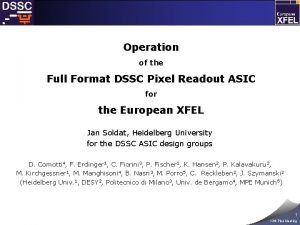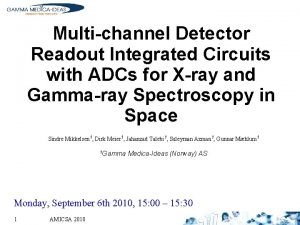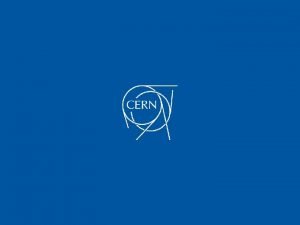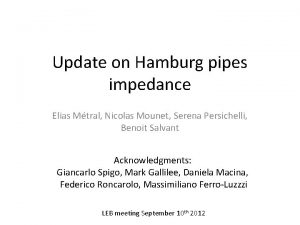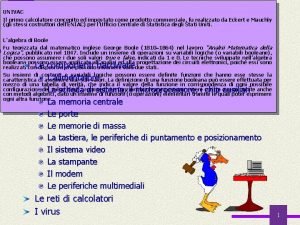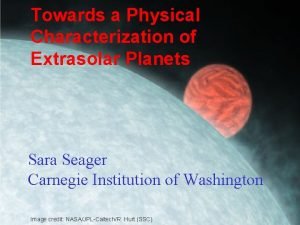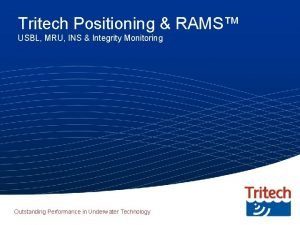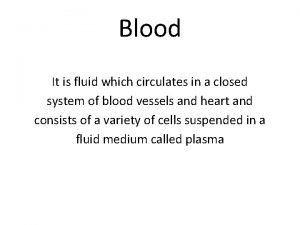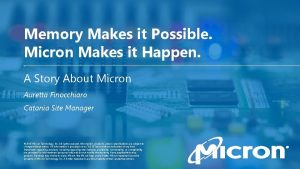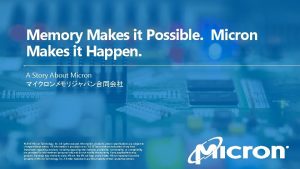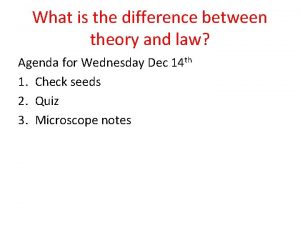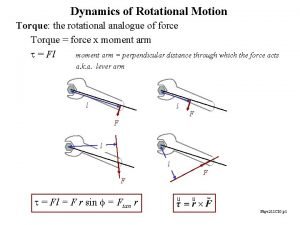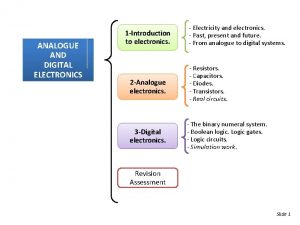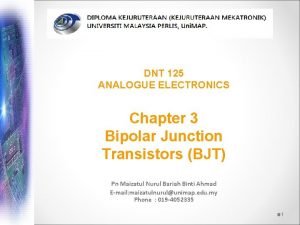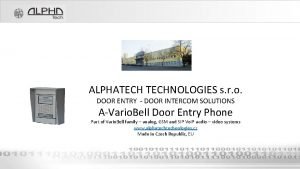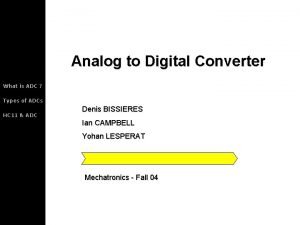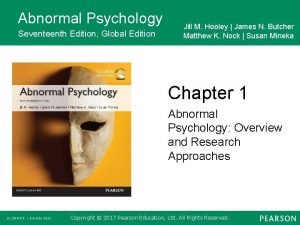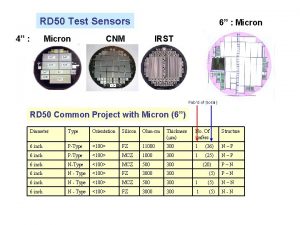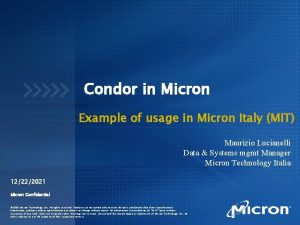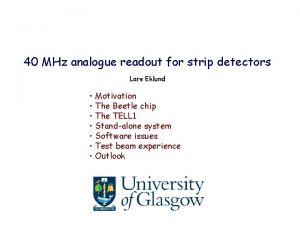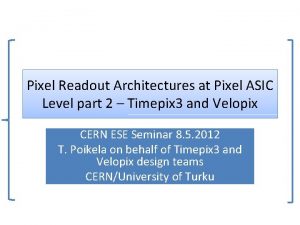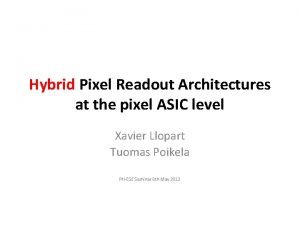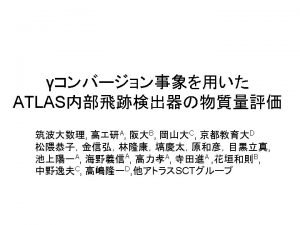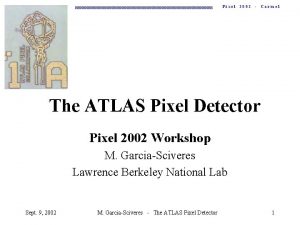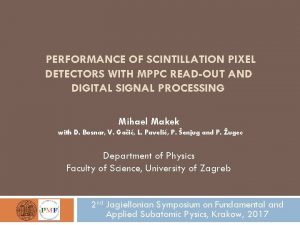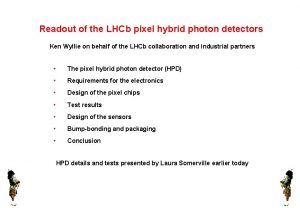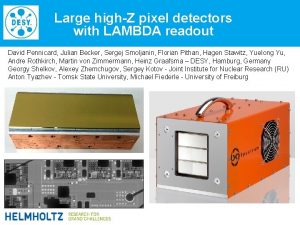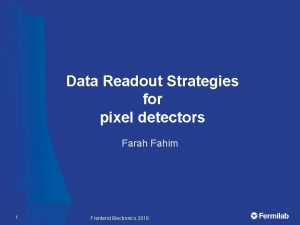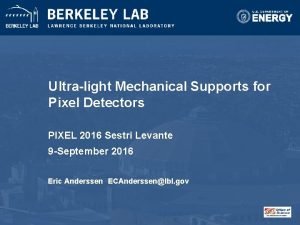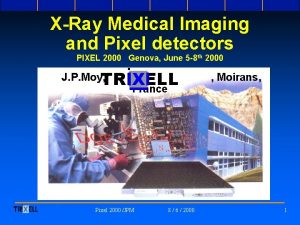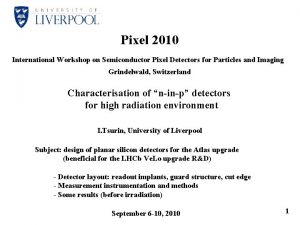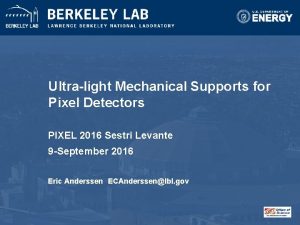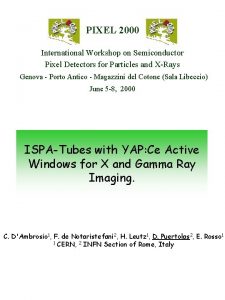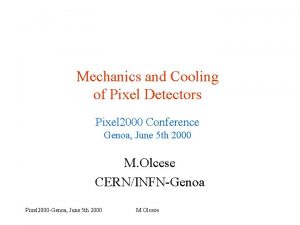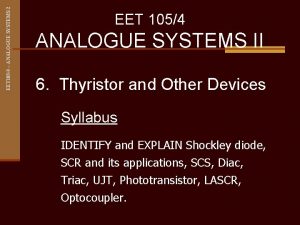Characterization of Micron pixel detectors with analogue readout





















- Slides: 21

Characterization of Micron pixel detectors with analogue readout after neutron irradiation *Dean Forshaw, T. Affolder, G. Casse, I. Tsurin, M. Wormald University of Liverpool 18 th RD 50 Workshop – Liverpool, 23 -25 May 2011 1

Outline • SCA pixel detectors Overview • Liverpool Alibava Setup • CC measurements • Cluster measurements • Analysis method • Strip data • Pixel data • Summery 18 th RD 50 Workshop – Liverpool, 23 -25 May 2011 2

Motivation The aim of my work was to assess the effects of neutron radiation damage on pixelated detectors designed for analogue readout, which provides a greater sensitivity thanks to a 12 bit ADC. Topics of interest: • The degradation of collected charge and charge sharing Via adjacent electrodes • Leakage current monitoring in irradiated detectors, to better assess there behaviour at high fluence, to provide a stable and safe operation for the detectors. • Micron FZ N-in-P Pixel detectors irradiated with 1 Me. V neutrons up to a maximum eq. fluence of 2·1016 neq/cm 2 • CC of the detectors tested with Liverpool Alibava setup 18 th RD 50 Workshop – Liverpool, 23 -25 May 2011 3

Detectors 2 types of detector; APC, APR Implant Geometry = N-in-P Bulk Silicon type = FZ Thickness = 300µm Resistivity = 13 Kohms Liverpool designed SCA based on FEI 3 • 50µm pitch • 2048 pixels: 400 by 50µm • APC/R DC Coupled • Read out by 2 beetle chips, AC Coupled • 8 interleaved pixels per column/row • 256 channels read out channels • Pixel matrix 16 x 128 implants • Wire bonding at room temp • Maximum resolved cluster size, 7 APC (dose 1 Me. V eq neutrons) APR (dose, 1 Me. V eq neutrons) 5 E 14 1 E 15 3 E 15 5 E 15 1 E 16 2 E 16 18 th RD 50 Workshop – Liverpool, 23 -25 May 2011 4

Irradiation sources Irradiation and dosimetry (Neutrons): Triga Reactor, Jozef Stefan Institute, Ljubljana, Slovenia: V. Cindro, I. Mandic et. al. 18 th RD 50 Workshop – Liverpool, 23 -25 May 2011 5

Detectors APC (Column Parallel) BEETLE 0 Good cluster resolution along Y axis 64 128 0 1 0 1 0 1 0 64 BEETLE 1 18 th RD 50 Workshop – Liverpool, 23 -25 May 2011 6

Detectors APR (Row Parallel) 128 CHANNELS ARE CONNECTED TO 128 PIXELS IN ROWS Even row numbers are connected to 1 beetle, and odd to the other BEETLE 0 ETC…. 16 Good cluster resolution along X axis 128 channels BEETLE 1 18 th RD 50 Workshop – Liverpool, 23 -25 May 2011 7

Pixel Detectors with Wire-bonded Readout pixel sensors with interleaved readout implants connected to wire bond pads Pulse shape analysis Cross-calibration of To. T Column-parallel / Row-parallel readout Fast “Cold” bonding to the readout for annealing studies Re-use of bonding pads No need to irradiate the readout -> good data quality No need to irradiate readout electronics which allows for the separation of radiation effects to the sensor from electronics Allows for simpler Resolution and Charge Collection studies Shuffled R/O channels to minimise the cross talk between connection lines 18 th RD 50 Workshop – Liverpool, 23 -25 May 2011 8

Alibava Setup Analogue readout based on the Beetle V 1. 5 chip (40 MHz readout speed) Signal generation with 370 Mbq 90 Sr fast beta source or IR Laser (980/1060 nm) for charge collection & sharing studies Detector attached to aluminium heat sink and cooled using fans to blow cold air over/under detector Cooling down to - 45 deg. C (El. Cold EL 11 LT), 1 deg. C hysteresis loop Scintilator/s placed under/on top daughter board for single or coincidence trigger 18 th RD 50 Workshop – Liverpool, 23 -25 May 2011 9

Analysis Noisy channels are easily spotted for masking Updated Alibava software developed at Liverpool, now implemented 12 -18 ns 18 th RD 50 Workshop – Liverpool, 23 -25 May 2011 10

Charge Collection Measurements 90 Sr fast electron source used to generate signal. Readout triggered by scintillator. Charge collection measured using analogue electronics chip (SCT 128 A or Beetle) clocked at LHC speed (40 MHz clock, 25 ns shaping time). System calibrated to most probable value of MIP energy loss in non-irradiated 310 m thick sensor (~ 23800 e). Data collected from 100, 000 events for voltages from 300 to 2000 volts, 100 V steps Collected measurement and pedestal file for each voltage, and calibration file for each DB at each temperature. 12 -18 ns 18 th RD 50 Workshop – Liverpool, 23 -25 May 2011 11

• • SEEDcut 5σ, NEIGHBOURcut 2σ Where 1σ is ~10 ADC @300 v σ will increase with Voltage! SEEDcut ~3125+ electrons NEIGHBOURcut ~1250+ electrons Daughter board calibration – Hamamatsu ATLAS 07 -P-SSSD_SERIES 2 – x 3 N-in-P ~310µm thick – Verifyed thickness, 314, 315, 317 ± 3µm Uniradiated 310µm N-in-P APC tested – Over depleted to 500 v with max signal ~21000 electrons, expected ~24000 Reduced gain seen, caused by DC coupled sensor read out via AC coupled frontend Gain normalised to typical AC-AC coupled detector-frontend values: • Gain normalisation value ~ 1. 15 • • • 18 th RD 50 Workshop – Liverpool, 23 -25 May 2011 12

STRIP/APR/APC comparison 25000 5 E 14 STRIP 1 E 16 STRIP 5 E 14 APC 1 E 16 APC 5 E 14 APR 1 E 16 APR Reduced gain effect shown, APC/R agrees well with each other Collected charge (electrons) Strip, APR, APC uncorrected 10000 5000 100 25000 300 500 700 900 Bias Voltage V 1100 1300 1500 1700 5 E 14 STRIP 1 E 16 STRIP 5 E 14 APC 1 E 16 APC 5 E 14 APR 1 E 16 APR 20000 Collected charge (electrons) Errors calculated by adding in quadrature, the discrepancy in CC from multiple fits and the calibration. Error range ~600 -1200 electrons 15000 0 Strip, APR, APC corrected All curves fit within errors. Errors not shown for ease of reading 20000 15000 10000 5000 0 100 300 900 Bias Voltage V 1100 18 th RD 50 Workshop – Liverpool, 23 -25 May 2011 1300 1500 1700 13

APC/APR corrected CC data Collected Charge (electrons) 30000 Multiplication in radiation damaged samples observed clearly at very high voltages in the 1 E 15, 3 E 15 samples APR 5. 00 E+14 25000 1. 00 E+15 3. 00 E+15 5. 00 E+15 20000 1. 00 E+16 2. 00 E+16 15000 10000 5000 0 200 Both samples performed as expected 700 30000 Collected Charge (electrons) 20000 1700 Bias Voltage V APC 5. 00 E+14 1. 00 E+15 3. 00 E+15 5. 00 E+15 1. 00 E+16 25000 1200 15000 10000 5000 0 200 700 1200 18 th RD 50 Workshop – Liverpool, 23 -25 May 2011 1700 Bias Voltage V 14

APC/APR current’s Need to separate self heating from multiplication, Power vs. Fluence study required o Need to better estimate sensor temperature o Prototype staves and cooling rigs with realistic cooling paths to check runaway modelling Corrected current µA Not clear if turn up of current is due to multiplication or thermal runaway due to the limitations of the cooling power of our system. 350 5. 00 E+14 300 3. 00 E+15 APC 1. 00 E+15 5. 00 E+15 250 1. 00 E+16 200 2. 00 E+16 150 100 50 0 0 200 400 600 800 450 1000 1200 Voltage V 1400 1600 1800 2000 APR 400 350 Corrected current µA Currents have been corrected to -25 deg. C, Errors are approximated to 1 deg. C change 400 5. 00 E+14 300 1. 00 E+15 3. 00 E+15 250 5. 00 E+15 200 1. 00 E+16 2. 00 E+16 150 100 50 0 0 200 400 600 800 1000 1200 Voltage V 1400 18 th RD 50 Workshop – Liverpool, 23 -25 May 2011 1600 1800 2000 15

APC Cluster profile APC 5 E 14 normalized cluster size APC 1 E 15 normalised cluster size 0, 45 400 0, 4 500 0, 6 700 0, 3 1000 0, 15 1200 0, 05 1300 0, 8 2 3 4 5 0, 4 0, 3 0, 2 0, 1 1 0 1 2 3 4 1900 0 400 500 600 700 800 900 1000 1100 1200 1300 1400 1500 1600 1700 1800 1900 2000 Unexplained anomalies 0, 6 1700 6 APC 3 E 15 normalised cluster size 0, 7 1500 0, 1 0 1 1300 0, 2 1100 0, 1 900 0, 3 900 0, 2 700 0, 4 800 0, 25 500 0, 5 600 0, 35 300 5 6 2 3 4 5 6 APC 5 E 15 normalized cluster size 300 0, 7 500 Bias voltage affecting charge sharing shown 0, 6 0, 5 0, 4 700 900 1100 0, 3 1300 0, 2 1500 0, 1 1700 0 1 2 3 18 th RD 50 Workshop – Liverpool, 23 -25 May 2011 4 5 6 16

APC Cluster profile APC 1 E 16 normalized cluster size 0, 7 600 All cluster statistics normalised to 1 total clusters 700 0, 6 800 0, 5 900 1000 0, 4 Signal sensitivity decrease’s analogue to binary behaviour 1100 0, 3 1200 0, 2 1300 1400 0, 1 1500 0 1 2 3 4 5 APC 2 E 16 normalized cluster size 6 0, 7 Cluster size 1 increased by ~72% over fluence range Cluster size 2 decreased by ~21% Cluster size 3 decreased by ~65% Cluster size 4 decreased by ~62% Cluster size 5 decreased by ~74% 0, 6 0, 5 600 0, 4 800 900 0, 3 1000 0, 2 1100 0, 1 1200 0 1 2 3 4 18 th RD 50 Workshop – Liverpool, 23 -25 May 2011 5 6 17

APR Cluster profile APR 5 E 14 normalized cluster size APR 1 E 15 normalized cluster size 300 0, 7 400 0, 8 0, 6 500 0, 7 600 0, 6 0, 5 700 0, 4 800 900 0, 3 0, 2 0, 1 0, 5 0, 4 1000 0, 3 1100 0, 2 1200 0, 1 1300 0 0 1 2 3 4 5 APR 3 E 15 normalized cluster size 0, 9 0, 8 0, 7 0, 6 0, 5 0, 4 0, 3 0, 2 0, 1 0 1 2 3 4 5 1 6 300 400 500 600 700 800 900 1000 1100 1200 1300 1400 1500 1600 1700 1800 1900 2000 6 400 500 600 700 800 900 1000 1100 1200 1300 1400 1500 1600 1700 1800 1900 2 3 4 5 6 APR 5 E 15 normalized cluster size 300 400 500 600 700 800 900 1000 1100 1200 1300 1400 1500 1600 1700 1800 1 0, 9 0, 8 0, 7 0, 6 0, 5 0, 4 0, 3 0, 2 0, 1 0 1 2 3 18 th RD 50 Workshop – Liverpool, 23 -25 May 2011 4 5 6 18

APR Cluster profile APR 1 E 16 normalized cluster size 500 1 600 0, 9 700 0, 8 800 All cluster statistics normalised to 1 total clusters 900 0, 7 Signal sensitivity decrease’s analogue to binary behaviour 1000 0, 6 1100 0, 5 1200 0, 4 1300 0, 3 1400 0, 2 1500 0, 1 1600 APC/R have different cluster behaviours shown here by there obvious differences in size 0 1 2 3 4 5 6 APR 2 E 16 normalized cluster size Cluster size 1 increased by ~179% over fluence range Cluster size 2 decreased by ~71% Cluster size 3 decreased by ~95% Cluster size 4 decreased by ~99% Cluster size 5 decreased by ~97% 1 0, 9 0, 8 0, 7 0, 6 0, 5 0, 4 0, 3 0, 2 0, 1 0 500 600 700 800 900 1000 1100 1200 1300 1 2 3 4 18 th RD 50 Workshop – Liverpool, 23 -25 May 2011 5 6 19

Conclusion The Liverpool designed analogue pixel sensors perform wonderfully, more work is needed on understanding the charge sharing i. e. cluster sizes in the 2 geometry's Detectors operate at large HV with minimal leakage current effects hindering performance, Need to separate self heating from multiplication components to better under stand detector life and signal at high fluence’s. 18 th RD 50 Workshop – Liverpool, 23 -25 May 2011 20

Thank you for your attention Any Questions? 18 th RD 50 Workshop – Liverpool, 23 -25 May 2011 21
 Full pixel readout
Full pixel readout Readout integrated circuit
Readout integrated circuit Readout units
Readout units Readout device
Readout device Micron reason for
Micron reason for Crt micron manuale italiano
Crt micron manuale italiano Micron wavelength
Micron wavelength Tritech micron
Tritech micron 8 micron
8 micron Micron automata
Micron automata Micron memory japan hiroshima
Micron memory japan hiroshima Difference between theory and law
Difference between theory and law Rotational analogue
Rotational analogue Analogue and digital electronics
Analogue and digital electronics Analogue chapter 3
Analogue chapter 3 Analog and digital signals in computer networking
Analog and digital signals in computer networking Analogue door phone
Analogue door phone Analogue and digital images
Analogue and digital images Write the time in digital form
Write the time in digital form أنواع adc
أنواع adc Analogue studies are used when researchers ____.
Analogue studies are used when researchers ____. Status digital analogue
Status digital analogue
